中考英语专题复习--动词时态
图片预览
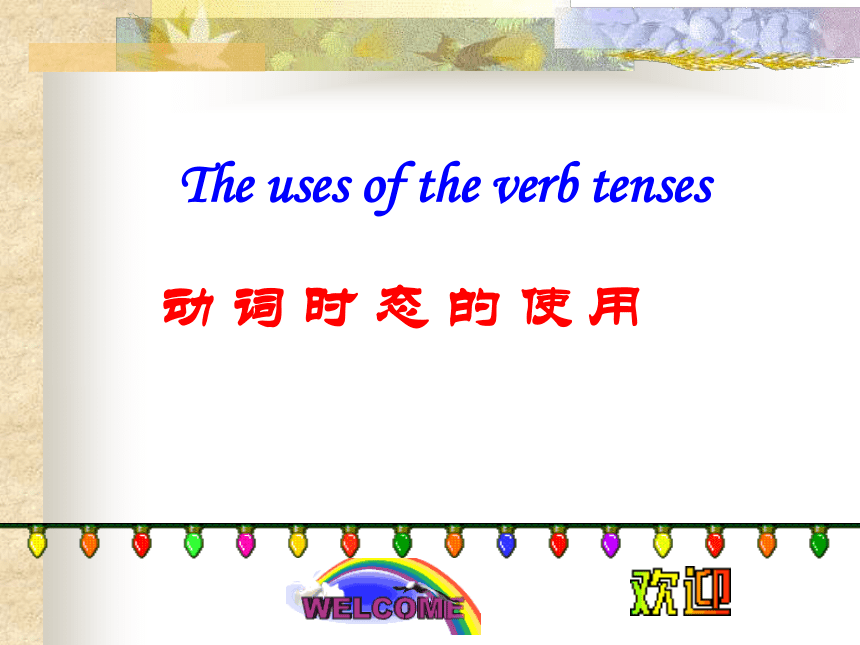
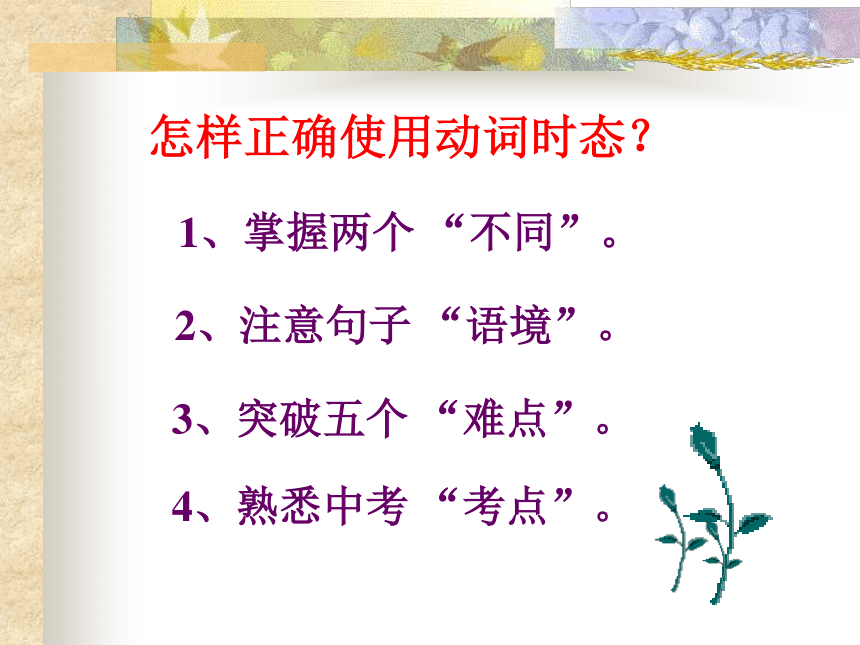
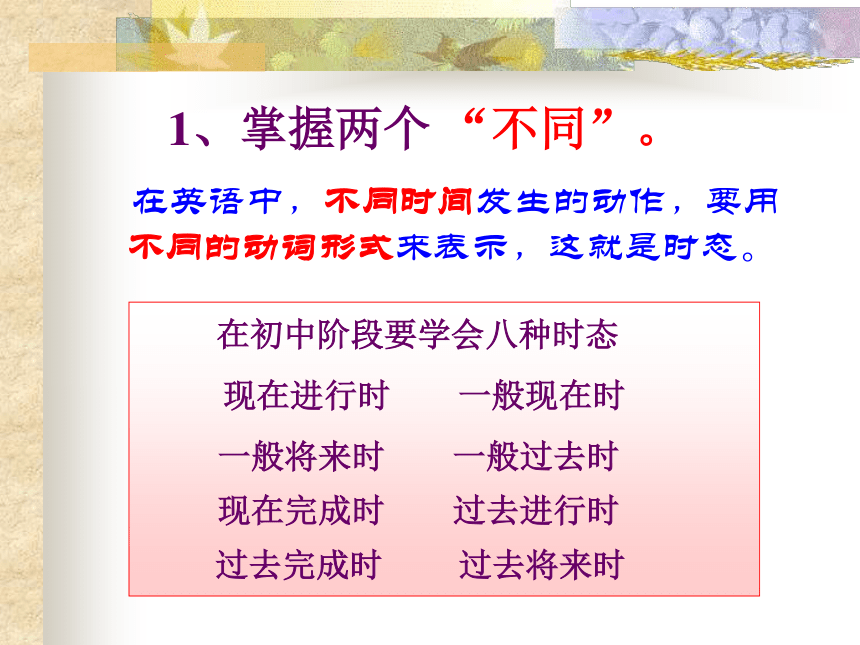
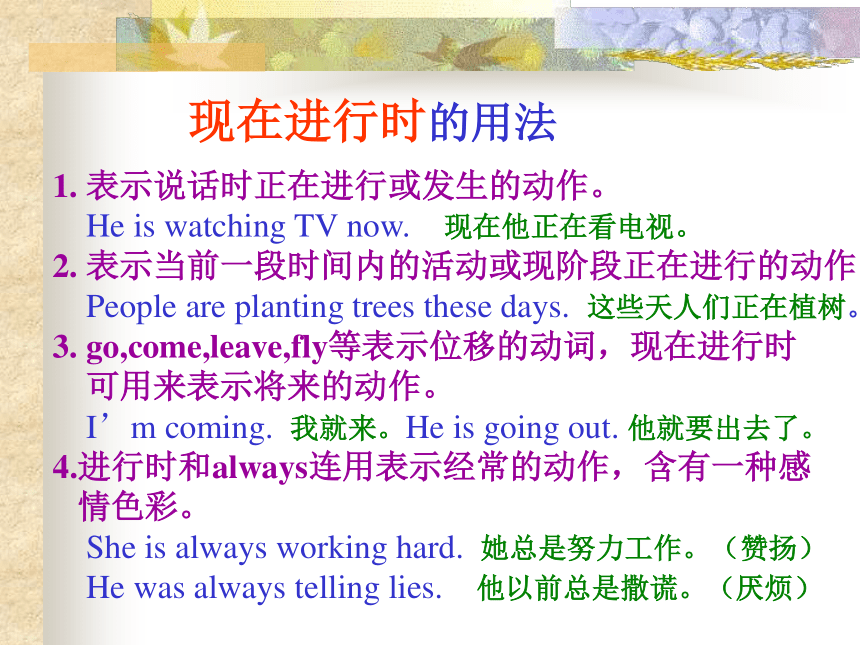
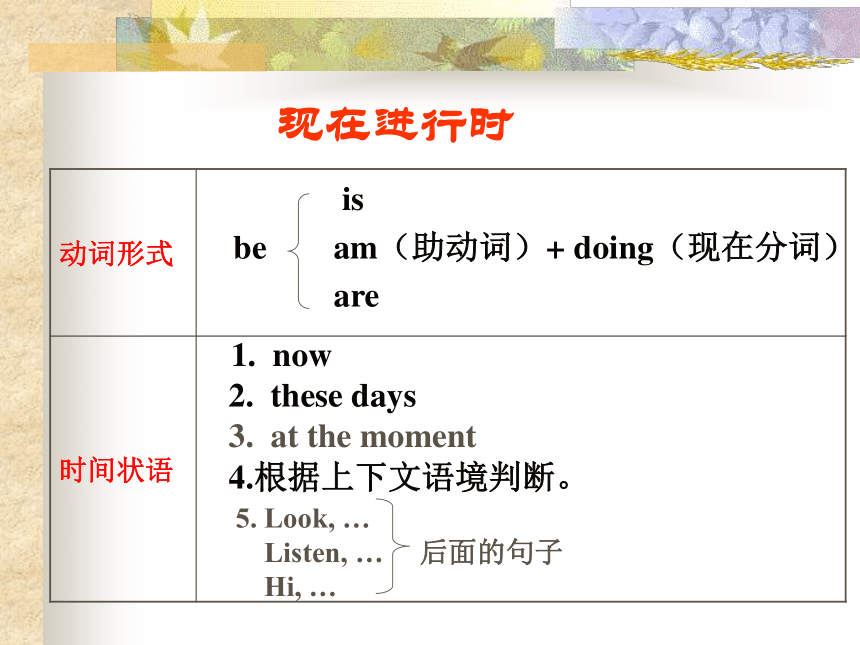
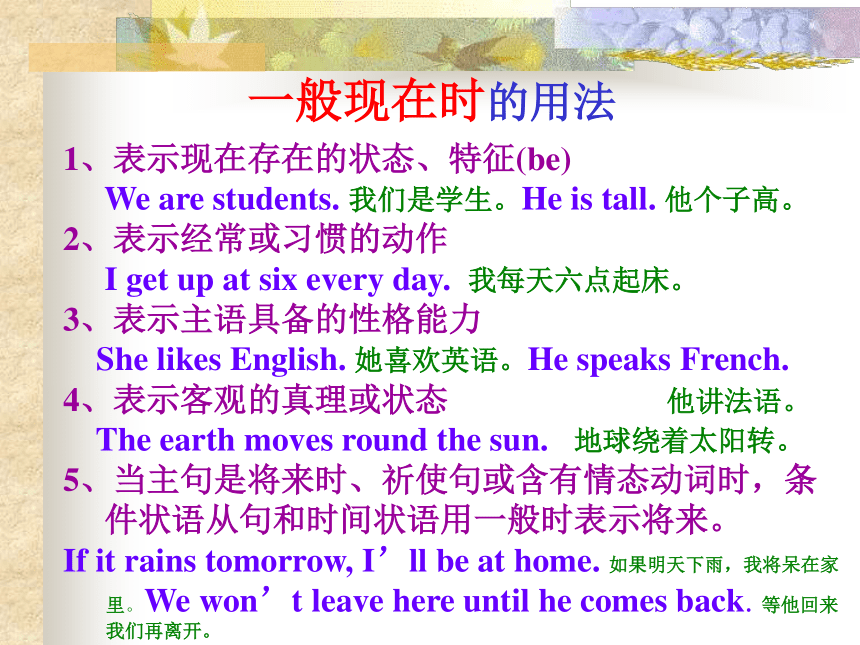
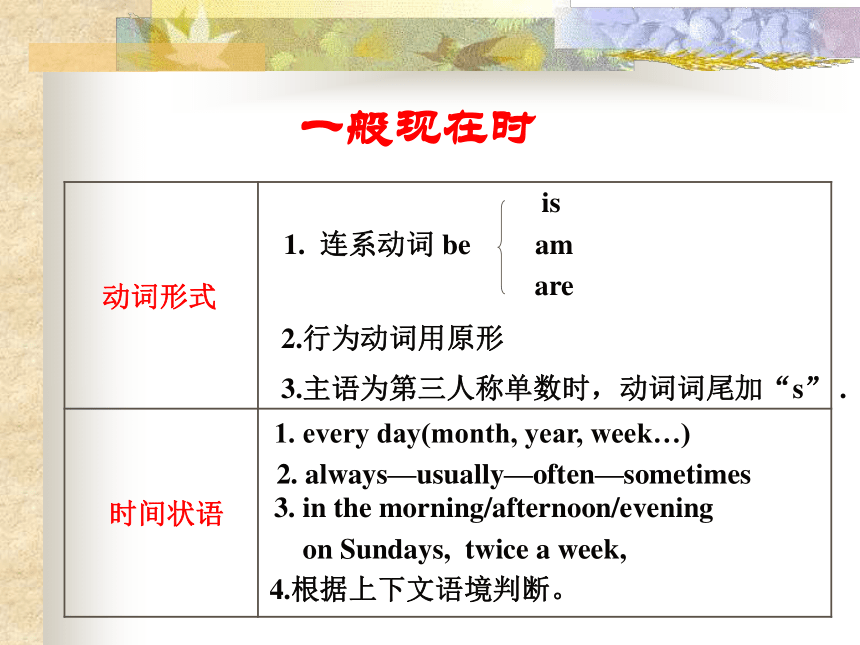
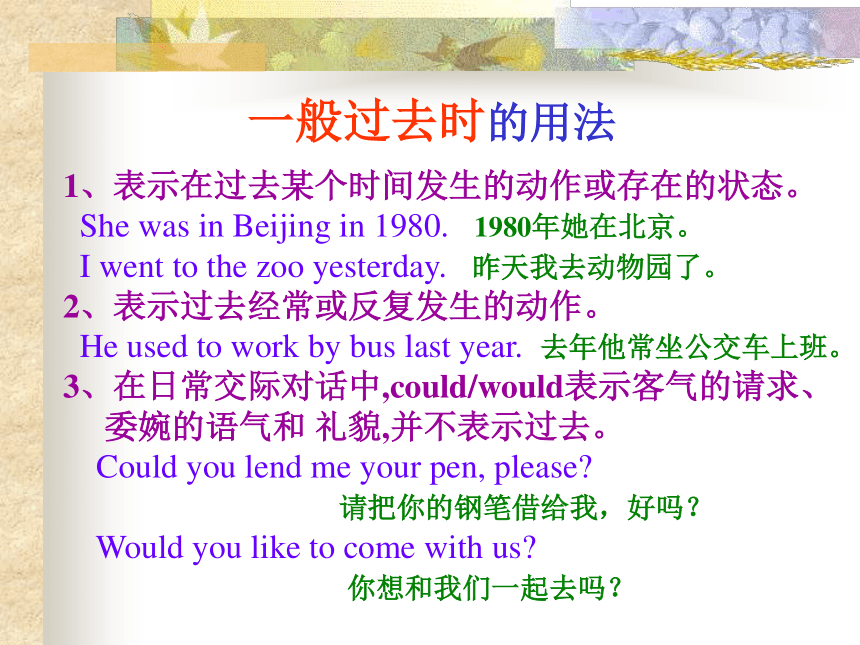
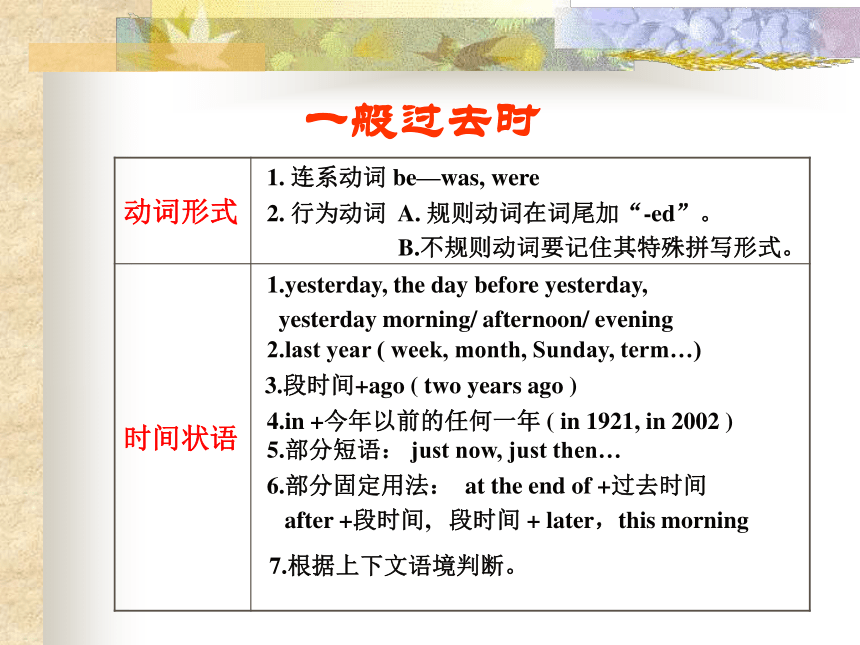
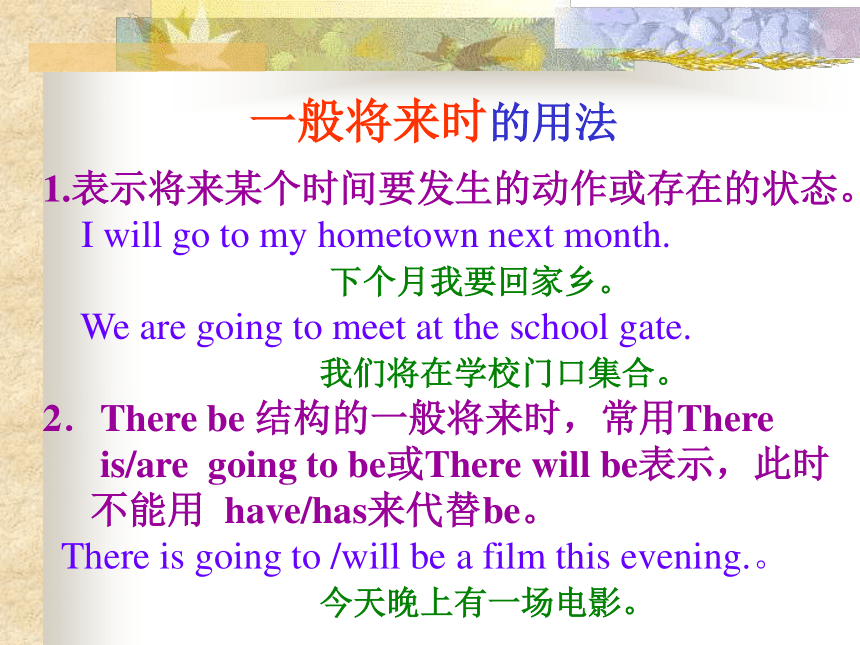
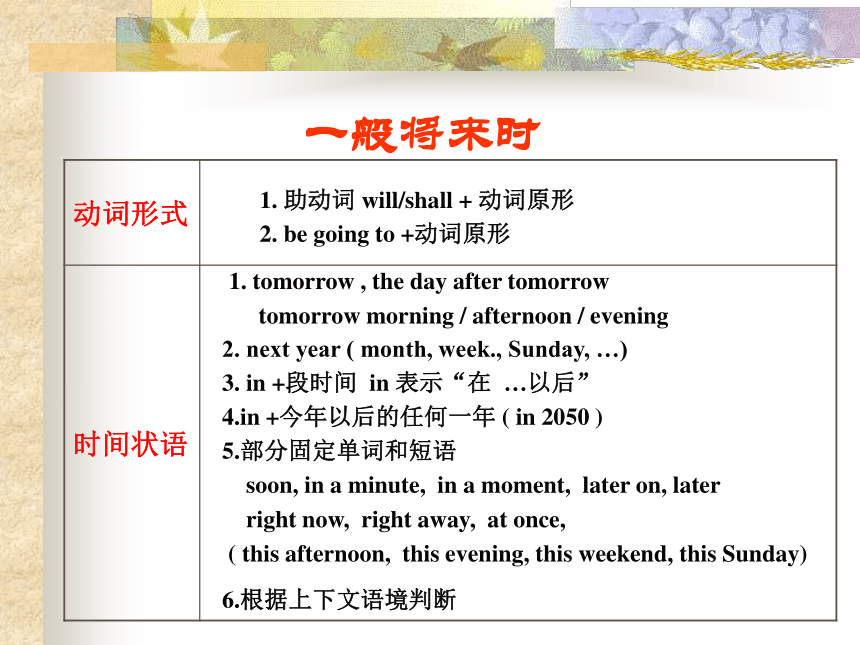
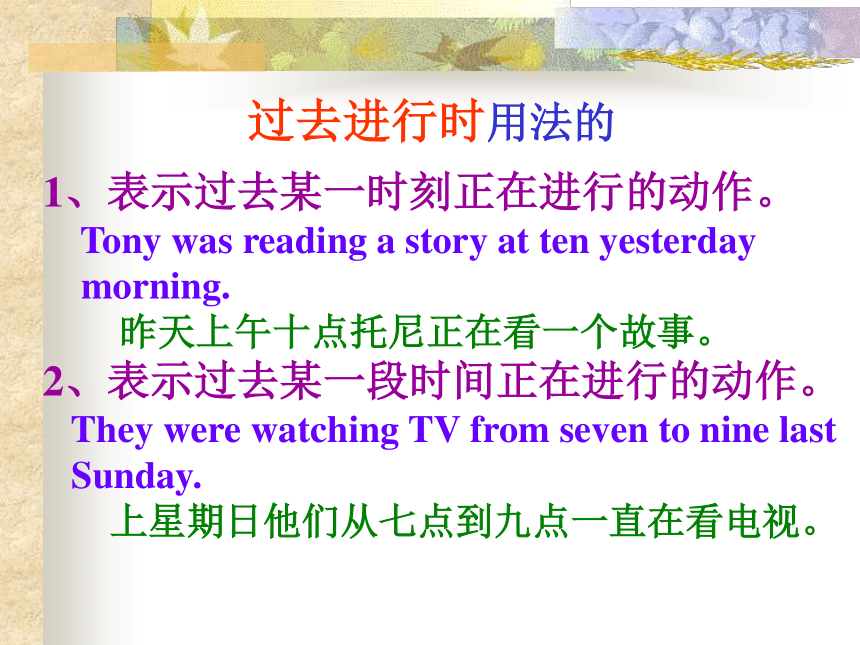
文档简介
(共43张PPT)
The uses of the verb tenses
动 词 时 态 的 使 用
3、突破五个 “难点”。
1、掌握两个 “不同”。
2、注意句子 “语境”。
4、熟悉中考 “考点”。
怎样正确使用动词时态?
在英语中,不同时间发生的动作,要用
不同的动词形式来表示,这就是时态。
在初中阶段要学会八种时态
现在进行时 一般现在时
一般将来时 一般过去时
现在完成时 过去进行时
过去完成时 过去将来时
1、掌握两个 “不同”。
现在进行时的用法
1. 表示说话时正在进行或发生的动作。
He is watching TV now. 现在他正在看电视。
2. 表示当前一段时间内的活动或现阶段正在进行的动作。
People are planting trees these days. 这些天人们正在植树。
3. go,come,leave,fly等表示位移的动词,现在进行时
可用来表示将来的动作。
I’m coming. 我就来。He is going out. 他就要出去了。
4.进行时和always连用表示经常的动作,含有一种感
彩。
She is always working hard. 她总是努力工作。(赞扬)
He was always telling lies. 他以前总是撒谎。(厌烦)
is
be am(助动词)+ doing(现在分词)
are
动词形式
时间状语
现在进行时
1. now
2. these days
4.根据上下文语境判断。
3. at the moment
5. Look, …
Listen, … 后面的句子
Hi, …
一般现在时的用法
1、表示现在存在的状态、特征(be)
We are students. 我们是学生。He is tall. 他个子高。
2、表示经常或习惯的动作
I get up at six every day. 我每天六点起床。
3、表示主语具备的性格能力
She likes English. 她喜欢英语。He speaks French.
4、表示客观的真理或状态 他讲法语。
The earth moves round the sun. 地球绕着太阳转。
5、当主句是将来时、祈使句或含有情态动词时,条
件状语从句和时间状语用一般时表示将来。
If it rains tomorrow, I’ll be at home. 如果明天下雨,我将呆在家里。We won’t leave here until he comes back. 等他回来我们再离开。
动词形式
时间状语
一般现在时
1. every day(month, year, week…)
is
1. 连系动词 be am
are
2.行为动词用原形
3.主语为第三人称单数时,动词词尾加“s” .
2. always—usually—often—sometimes
3. in the morning/afternoon/evening
on Sundays, twice a week,
4.根据上下文语境判断。
一般过去时的用法
1、表示在过去某个时间发生的动作或存在的状态。
She was in Beijing in 1980. 1980年她在北京。
I went to the zoo yesterday. 昨天我去动物园了。
2、表示过去经常或反复发生的动作。
He used to work by bus last year. 去年他常坐公交车上班。
3、在日常交际对话中,could/would表示客气的请求、
委婉的语气和 礼貌,并不表示过去。
Could you lend me your pen, please
请把你的钢笔借给我,好吗?
Would you like to come with us
你想和我们一起去吗?
动词形式
时间状语
一般过去时
1. 连系动词 be—was, were
1.yesterday, the day before yesterday,
yesterday morning/ afternoon/ evening
2. 行为动词 A. 规则动词在词尾加“-ed”。
B.不规则动词要记住其特殊拼写形式。
2.last year ( week, month, Sunday, term…)
3.段时间+ago ( two years ago )
4.in +今年以前的任何一年 ( in 1921, in 2002 )
5.部分短语: just now, just then…
6.部分固定用法: at the end of +过去时间
after +段时间, 段时间 + later,this morning
7.根据上下文语境判断。
一般将来时的用法
1.表示将来某个时间要发生的动作或存在的状态。
I will go to my hometown next month.
下个月我要回家乡。
We are going to meet at the school gate.
我们将在学校门口集合。
2.There be 结构的一般将来时,常用There
is/are going to be或There will be表示,此时
不能用 have/has来代替be。
There is going to /will be a film this evening.。
今天晚上有一场电影。
动词形式
时间状语
一般将来时
1. 助动词 will/shall + 动词原形
1. tomorrow , the day after tomorrow
tomorrow morning / afternoon / evening
2. be going to +动词原形
2. next year ( month, week., Sunday, …)
3. in +段时间 in 表示“在 …以后”
4.in +今年以后的任何一年 ( in 2050 )
5.部分固定单词和短语
soon, in a minute, in a moment, later on, later
right now, right away, at once,
( this afternoon, this evening, this weekend, this Sunday)
6.根据上下文语境判断
过去进行时用法的
1、表示过去某一时刻正在进行的动作。
Tony was reading a story at ten yesterday
morning.
昨天上午十点托尼正在看一个故事。
2、表示过去某一段时间正在进行的动作。
They were watching TV from seven to nine last
Sunday.
上星期日他们从七点到九点一直在看电视。
动词形式
时间状语
过去进行时
助动词 was / were + doing
1 . 点时间
at ten yesterday / last Sunday
at noon yesterday
at this time yesterday
at that time/at that moment
以 “when+过去时”的时间状语从句
2. 段时间
from… to … yesterday
the whole evening yesterday
last night
现在完成时的用法
1、表示过去发生或已经完成的某一动作对现在造成的
影响或结果。
I have opened the door. 我把门打开了。(门现在是开着的)
2、表示过去已经开始,持续到现在的动作或状态。
They have lived here since 1989. 自从1989年他们就住在这。
He has had the book for two weeks.这本书他买了两周了。
3、have been to 意为“曾经去过某地”,表示一种经历。
have gone to 意为“到某地去了(人不在这儿)”。
The twins have been to London twice.双胞胎去过伦敦两次。
Mr Wang isn’t at school. He has gone to Beijing.
王老师不在学校,他去北京了。
动词形式
时间状语
现在完成时
助动词 have / has + 过去分词
1. 和六个时间副词连用
用于肯定句 : already, just
用于否定句 : never , yet before
用于疑问句 : ever, yet
2. for + 段时间 ( for three hours)
1989
点时间 two years ago
since + September
从句 (过去时)
3. in the last … years , during the past … years
so far到目前为止, ever since自从… recently 最近
4. twice , four times
5.根据上下文语境判断。
过去完成时的用法
表示在过去某一时间或动作之前已经发生或完成了的动作。
也被称为“过去的过去”。
When we got there, the film had begun.
当我们到那儿的时候,电影已经开演了。
By the end of last term we had learned 2000
English words. 到上学期期末的时候,我们
已经学了2000个英语单词了。
动词形式
时间状语
过去完成时
had + 过去分词
1.by + 过去时间 by 3:40 yesterday
2.by the end of + 过去时间
3.when 从句(过去时)
4.before 从句(过去时)
5.already, before, never, yet 等副词。
6.根据上下文语境判断。
过去将来时的用法
表示从过去的某一时间看来将要发生的动作或存在的状态。
也被称为“过去的将来”。
常用在宾语从句中。
I didn’t know if he would come.
我不知道他是否会来。
Jim said that he would visit his uncle
the next week. 。吉姆说他下星期去看他叔叔。
动词形式
时间状语
过去将来时
1. 没有特定的时间状语。
would +动词原形
was/were going to +动词原形
2. 在宾语从句中,常用 the next week,
the next month… soon 等
相似时间状语辨析
twice
twice a week
现在完成时
一般现在时
2. two days ago
since two days ago
一般过去时
现在完成时
3. at the end of last month
by the end of last month
一般过去时
过去完成时
相似时间状语辨析
4. after three weeks
in three weeks
一般过去时
一般将来时
5. yesterday
at ten yesterday
一般过去时
过去进行时
6. next week
the next week
一般将来时
过去将来时
7. just now
right now
一般过去时
一般将来时
8. two days later
later on
一般过去时
一般将来时
9. in 1952
in 2050
一般过去时
一般将来时
10. at 5:00 yesterday
by 5:00 yesterday
过去进行时
过去完成时
11. in 2005
since 2005
一般过去时
现在完成时
12. last Sunday
next Sunday
一般过去时
一般将来时
13. this morning
in the morning
一般过去时
一般现在时
14. at the moment
at that moment
现在进行时
过去进行时
根据语境和上下文意义判断不同的时态。
( ) 1. Miss Liu is still single. She ________________ .
A. is not marry B. had not been married
C. was not married D. is not married
D
( ) 2. Uncle Wang stopped _________a rest
because he ____________ for three hours.
A. having ;had worked
B. having ;has worked
C. to have;had worked
D. to have;has worked
C
2. 注意句子“语境”:
is not married
to have
had worked
( ) 3. In England people their middle
names very much.
A. didn’t use B. aren’t using
C. won’t use D. don’t use
don’t use
( ) 4. Don’t worry. I you.
A. helped B. will help
C. helping D. help
will help
( ) 5. I after my young brother because
Mother has gone to the meeting.
A. will look B. looked
C. am looking D. have looked
am looking
D
B
C
难点①:现在完成时和过去时的区别。
过去时只表示某个动作发生在过去的某个时间,
和现在没关系。
现在完成时则强调发生在过去的某一 动作,对
现在造成的影响或结果,指的是现在的情况。
( ) 1. We _____ all the money,so we have to walk
home.
A. spend B. spent
C. have spent D. had spent
C
3. 突破五个 “难点”:
( ) 2. The fog ___ and the sun is shining
brightly.
A. went away B. has gone away
C. lifted D. has lifted
D
( )3.The raining season ______ , so
everything is damp.
A. will begin B. was beginning
C. has begun D. begun
C
( ) 4. You don’t need to describe her. I ___
her several times.
A. had met B. met
C.have met D. meet
C
( )5. I won’t go to see the football match
tonight, because I ____ my ticket.
A. didn’t have B. lost
C. have lost D. will lost
C
●
●
past
1998
now
2008
for ten years
since 1998
难点②:段时间必须和延续性动词连用
火车已经开走了。
火车已经开走十分钟了。
The train has left.
The train has left for ten minutes.
The train has been away for ten minutes.
×
段时间必须和延续性动词连用
短暂性动词: 动作一发生就立刻结束,不再延续。
短暂性动词不能和段时间连用,如句子里有“段时间”,
可以换用延续性动词表示相同的意义。常见的动词如下:
go /come -- be in/at/on open -- be open(adj.)
leave -- be away close -- be closed
buy -- have arrive/reach -- be in
borrow -- keep finish/end -- be over
begin /start-- be on meet/see -- know
die -- be dead receive -- have
join -- be in/be a member of get up – be up
段时间必须和延续性动词连用
( ) 1. “How long he Tianjin ”
“For 8 year.”
A. has;left B. will;leave
C. is leaving D. has;been away from
D
( ) 2. Where is Miss Zhao The parents have__
the classroom since three o’clock.
A. arrived B. been to
C. reached D. been in
D
( ) 3. Their bookshop____ since three years ago.
A. was open B. has been opened
C. has been open D. has opened
C
( ) 4. He went to Toronto two years ago, so
he___ Toronto for two years.
A. has been to B. has gone to
C. has been in D. has gone
C
( ) 5. He _____ the bike for two years.
A. bought B. has bought
C. had D. has had
D
have been to 去过某地(表示经历)
区别
have gone to 去某地了(人不在这)
这两个短语
在用法上有
三不能
1、不能和段时间连用
2、to后不能加副词here或there
如有副词要去掉to
3、have gone to的主语不能是第
一、二人称
难点③: have been to和have gone to的区别。
( )1. The children from that village have
never _____ Beijing .
A. gone to B. been in
C. been to D. been at
C
( ) 2. Linda _____ to the post office. You
can call her half an hour later.
A. has been B. has gone
C. is going D. went
B
( ) 3. I like Guilin, I___ there twice.
A. go B. went
C. have gone D. have been
D
( ) 4. --Where’s Lilei --He____ Beijing.
A. goes to B. went to
C. has gone to D. has been to
C
( ) 5. Miss Li ____ to London before. Now
she ____ to Paris. She’ll be back soon.
A. has gone, has gone B. went,went
C. has been, has gone D. has been,went
C
if
when
1.主句为一般将来时+ as soon as 从句为一般现在时
after
before
until
难点④:复合句中的时态呼应。
1、状语从句:
现在完成时
2.主句为 + since 从句为过去时
It’s + 段时间
过去时
3.主句为 过去进行时 + when 从句为过去时
过去完成时
( ) 1.He’s lived here____ 1980.
A. after B. in C. from D. since
2002
1. 现在完成时 + (介词) since two years ago 点时间
October
since 引导的短语或从句作为
时间状语的两个句型
( ) 2. Mr. Green____ in China since five years
ago.
A. lived B. has lived
C. lives D. is going to live
D
B
现在完成时
2.主句为 + (连词)since 从句为过去时
It’s + 段时间
We have made many friends since we came to China.
It’s three years since we came to China.
( )1. I__ a letter from him since he left.
A. didn’t B. haven’t got
C. didn’t have D. haven’t heard
B
( ) 2. Jim has made many friends since he___ to
China.
A. came B. comes C. has comes D. will come
A
2、宾语从句:
主句为一般时,宾语从句中可根据句意
使用六种时态中任意的一种。
(主现从六)
主句为过去时,宾语从句中必须用过去时的某种时态。
客观真理时用一般时
(主过从五)
be
(时态通过be来表示)
难点⑤:被动语态中的时态使用。
被动语态:助动词 + 及物动词的过去分词(p.p)
一般现在时 is, am, are p.p
一般过去时 was, were p.p
一般将来时 will be p.p
现在进行时 be being p.p
现在完成时 has/have been p.p
情态动词 must/can/may be p.p
( ) 38. Help! Wang Qing ____ an accident.
A.was having B. had had
C. has had D. will have
( ) 39. The telephone _____ by Alexander
Graham Bell in 1876
A. was invented B. has been invented
C. is invented D. will be invented
( ) 43. ----Can you tell me ____ ---- Yesterday.
A. when did he buy the car
B. where did he buy the car
C. when he bought the car
D. where he bought the car
C
A
C
4.熟悉中考 “考点”
The uses of the verb tenses
动 词 时 态 的 使 用
3、突破五个 “难点”。
1、掌握两个 “不同”。
2、注意句子 “语境”。
4、熟悉中考 “考点”。
怎样正确使用动词时态?
在英语中,不同时间发生的动作,要用
不同的动词形式来表示,这就是时态。
在初中阶段要学会八种时态
现在进行时 一般现在时
一般将来时 一般过去时
现在完成时 过去进行时
过去完成时 过去将来时
1、掌握两个 “不同”。
现在进行时的用法
1. 表示说话时正在进行或发生的动作。
He is watching TV now. 现在他正在看电视。
2. 表示当前一段时间内的活动或现阶段正在进行的动作。
People are planting trees these days. 这些天人们正在植树。
3. go,come,leave,fly等表示位移的动词,现在进行时
可用来表示将来的动作。
I’m coming. 我就来。He is going out. 他就要出去了。
4.进行时和always连用表示经常的动作,含有一种感
彩。
She is always working hard. 她总是努力工作。(赞扬)
He was always telling lies. 他以前总是撒谎。(厌烦)
is
be am(助动词)+ doing(现在分词)
are
动词形式
时间状语
现在进行时
1. now
2. these days
4.根据上下文语境判断。
3. at the moment
5. Look, …
Listen, … 后面的句子
Hi, …
一般现在时的用法
1、表示现在存在的状态、特征(be)
We are students. 我们是学生。He is tall. 他个子高。
2、表示经常或习惯的动作
I get up at six every day. 我每天六点起床。
3、表示主语具备的性格能力
She likes English. 她喜欢英语。He speaks French.
4、表示客观的真理或状态 他讲法语。
The earth moves round the sun. 地球绕着太阳转。
5、当主句是将来时、祈使句或含有情态动词时,条
件状语从句和时间状语用一般时表示将来。
If it rains tomorrow, I’ll be at home. 如果明天下雨,我将呆在家里。We won’t leave here until he comes back. 等他回来我们再离开。
动词形式
时间状语
一般现在时
1. every day(month, year, week…)
is
1. 连系动词 be am
are
2.行为动词用原形
3.主语为第三人称单数时,动词词尾加“s” .
2. always—usually—often—sometimes
3. in the morning/afternoon/evening
on Sundays, twice a week,
4.根据上下文语境判断。
一般过去时的用法
1、表示在过去某个时间发生的动作或存在的状态。
She was in Beijing in 1980. 1980年她在北京。
I went to the zoo yesterday. 昨天我去动物园了。
2、表示过去经常或反复发生的动作。
He used to work by bus last year. 去年他常坐公交车上班。
3、在日常交际对话中,could/would表示客气的请求、
委婉的语气和 礼貌,并不表示过去。
Could you lend me your pen, please
请把你的钢笔借给我,好吗?
Would you like to come with us
你想和我们一起去吗?
动词形式
时间状语
一般过去时
1. 连系动词 be—was, were
1.yesterday, the day before yesterday,
yesterday morning/ afternoon/ evening
2. 行为动词 A. 规则动词在词尾加“-ed”。
B.不规则动词要记住其特殊拼写形式。
2.last year ( week, month, Sunday, term…)
3.段时间+ago ( two years ago )
4.in +今年以前的任何一年 ( in 1921, in 2002 )
5.部分短语: just now, just then…
6.部分固定用法: at the end of +过去时间
after +段时间, 段时间 + later,this morning
7.根据上下文语境判断。
一般将来时的用法
1.表示将来某个时间要发生的动作或存在的状态。
I will go to my hometown next month.
下个月我要回家乡。
We are going to meet at the school gate.
我们将在学校门口集合。
2.There be 结构的一般将来时,常用There
is/are going to be或There will be表示,此时
不能用 have/has来代替be。
There is going to /will be a film this evening.。
今天晚上有一场电影。
动词形式
时间状语
一般将来时
1. 助动词 will/shall + 动词原形
1. tomorrow , the day after tomorrow
tomorrow morning / afternoon / evening
2. be going to +动词原形
2. next year ( month, week., Sunday, …)
3. in +段时间 in 表示“在 …以后”
4.in +今年以后的任何一年 ( in 2050 )
5.部分固定单词和短语
soon, in a minute, in a moment, later on, later
right now, right away, at once,
( this afternoon, this evening, this weekend, this Sunday)
6.根据上下文语境判断
过去进行时用法的
1、表示过去某一时刻正在进行的动作。
Tony was reading a story at ten yesterday
morning.
昨天上午十点托尼正在看一个故事。
2、表示过去某一段时间正在进行的动作。
They were watching TV from seven to nine last
Sunday.
上星期日他们从七点到九点一直在看电视。
动词形式
时间状语
过去进行时
助动词 was / were + doing
1 . 点时间
at ten yesterday / last Sunday
at noon yesterday
at this time yesterday
at that time/at that moment
以 “when+过去时”的时间状语从句
2. 段时间
from… to … yesterday
the whole evening yesterday
last night
现在完成时的用法
1、表示过去发生或已经完成的某一动作对现在造成的
影响或结果。
I have opened the door. 我把门打开了。(门现在是开着的)
2、表示过去已经开始,持续到现在的动作或状态。
They have lived here since 1989. 自从1989年他们就住在这。
He has had the book for two weeks.这本书他买了两周了。
3、have been to 意为“曾经去过某地”,表示一种经历。
have gone to 意为“到某地去了(人不在这儿)”。
The twins have been to London twice.双胞胎去过伦敦两次。
Mr Wang isn’t at school. He has gone to Beijing.
王老师不在学校,他去北京了。
动词形式
时间状语
现在完成时
助动词 have / has + 过去分词
1. 和六个时间副词连用
用于肯定句 : already, just
用于否定句 : never , yet before
用于疑问句 : ever, yet
2. for + 段时间 ( for three hours)
1989
点时间 two years ago
since + September
从句 (过去时)
3. in the last … years , during the past … years
so far到目前为止, ever since自从… recently 最近
4. twice , four times
5.根据上下文语境判断。
过去完成时的用法
表示在过去某一时间或动作之前已经发生或完成了的动作。
也被称为“过去的过去”。
When we got there, the film had begun.
当我们到那儿的时候,电影已经开演了。
By the end of last term we had learned 2000
English words. 到上学期期末的时候,我们
已经学了2000个英语单词了。
动词形式
时间状语
过去完成时
had + 过去分词
1.by + 过去时间 by 3:40 yesterday
2.by the end of + 过去时间
3.when 从句(过去时)
4.before 从句(过去时)
5.already, before, never, yet 等副词。
6.根据上下文语境判断。
过去将来时的用法
表示从过去的某一时间看来将要发生的动作或存在的状态。
也被称为“过去的将来”。
常用在宾语从句中。
I didn’t know if he would come.
我不知道他是否会来。
Jim said that he would visit his uncle
the next week. 。吉姆说他下星期去看他叔叔。
动词形式
时间状语
过去将来时
1. 没有特定的时间状语。
would +动词原形
was/were going to +动词原形
2. 在宾语从句中,常用 the next week,
the next month… soon 等
相似时间状语辨析
twice
twice a week
现在完成时
一般现在时
2. two days ago
since two days ago
一般过去时
现在完成时
3. at the end of last month
by the end of last month
一般过去时
过去完成时
相似时间状语辨析
4. after three weeks
in three weeks
一般过去时
一般将来时
5. yesterday
at ten yesterday
一般过去时
过去进行时
6. next week
the next week
一般将来时
过去将来时
7. just now
right now
一般过去时
一般将来时
8. two days later
later on
一般过去时
一般将来时
9. in 1952
in 2050
一般过去时
一般将来时
10. at 5:00 yesterday
by 5:00 yesterday
过去进行时
过去完成时
11. in 2005
since 2005
一般过去时
现在完成时
12. last Sunday
next Sunday
一般过去时
一般将来时
13. this morning
in the morning
一般过去时
一般现在时
14. at the moment
at that moment
现在进行时
过去进行时
根据语境和上下文意义判断不同的时态。
( ) 1. Miss Liu is still single. She ________________ .
A. is not marry B. had not been married
C. was not married D. is not married
D
( ) 2. Uncle Wang stopped _________a rest
because he ____________ for three hours.
A. having ;had worked
B. having ;has worked
C. to have;had worked
D. to have;has worked
C
2. 注意句子“语境”:
is not married
to have
had worked
( ) 3. In England people their middle
names very much.
A. didn’t use B. aren’t using
C. won’t use D. don’t use
don’t use
( ) 4. Don’t worry. I you.
A. helped B. will help
C. helping D. help
will help
( ) 5. I after my young brother because
Mother has gone to the meeting.
A. will look B. looked
C. am looking D. have looked
am looking
D
B
C
难点①:现在完成时和过去时的区别。
过去时只表示某个动作发生在过去的某个时间,
和现在没关系。
现在完成时则强调发生在过去的某一 动作,对
现在造成的影响或结果,指的是现在的情况。
( ) 1. We _____ all the money,so we have to walk
home.
A. spend B. spent
C. have spent D. had spent
C
3. 突破五个 “难点”:
( ) 2. The fog ___ and the sun is shining
brightly.
A. went away B. has gone away
C. lifted D. has lifted
D
( )3.The raining season ______ , so
everything is damp.
A. will begin B. was beginning
C. has begun D. begun
C
( ) 4. You don’t need to describe her. I ___
her several times.
A. had met B. met
C.have met D. meet
C
( )5. I won’t go to see the football match
tonight, because I ____ my ticket.
A. didn’t have B. lost
C. have lost D. will lost
C
●
●
past
1998
now
2008
for ten years
since 1998
难点②:段时间必须和延续性动词连用
火车已经开走了。
火车已经开走十分钟了。
The train has left.
The train has left for ten minutes.
The train has been away for ten minutes.
×
段时间必须和延续性动词连用
短暂性动词: 动作一发生就立刻结束,不再延续。
短暂性动词不能和段时间连用,如句子里有“段时间”,
可以换用延续性动词表示相同的意义。常见的动词如下:
go /come -- be in/at/on open -- be open(adj.)
leave -- be away close -- be closed
buy -- have arrive/reach -- be in
borrow -- keep finish/end -- be over
begin /start-- be on meet/see -- know
die -- be dead receive -- have
join -- be in/be a member of get up – be up
段时间必须和延续性动词连用
( ) 1. “How long he Tianjin ”
“For 8 year.”
A. has;left B. will;leave
C. is leaving D. has;been away from
D
( ) 2. Where is Miss Zhao The parents have__
the classroom since three o’clock.
A. arrived B. been to
C. reached D. been in
D
( ) 3. Their bookshop____ since three years ago.
A. was open B. has been opened
C. has been open D. has opened
C
( ) 4. He went to Toronto two years ago, so
he___ Toronto for two years.
A. has been to B. has gone to
C. has been in D. has gone
C
( ) 5. He _____ the bike for two years.
A. bought B. has bought
C. had D. has had
D
have been to 去过某地(表示经历)
区别
have gone to 去某地了(人不在这)
这两个短语
在用法上有
三不能
1、不能和段时间连用
2、to后不能加副词here或there
如有副词要去掉to
3、have gone to的主语不能是第
一、二人称
难点③: have been to和have gone to的区别。
( )1. The children from that village have
never _____ Beijing .
A. gone to B. been in
C. been to D. been at
C
( ) 2. Linda _____ to the post office. You
can call her half an hour later.
A. has been B. has gone
C. is going D. went
B
( ) 3. I like Guilin, I___ there twice.
A. go B. went
C. have gone D. have been
D
( ) 4. --Where’s Lilei --He____ Beijing.
A. goes to B. went to
C. has gone to D. has been to
C
( ) 5. Miss Li ____ to London before. Now
she ____ to Paris. She’ll be back soon.
A. has gone, has gone B. went,went
C. has been, has gone D. has been,went
C
if
when
1.主句为一般将来时+ as soon as 从句为一般现在时
after
before
until
难点④:复合句中的时态呼应。
1、状语从句:
现在完成时
2.主句为 + since 从句为过去时
It’s + 段时间
过去时
3.主句为 过去进行时 + when 从句为过去时
过去完成时
( ) 1.He’s lived here____ 1980.
A. after B. in C. from D. since
2002
1. 现在完成时 + (介词) since two years ago 点时间
October
since 引导的短语或从句作为
时间状语的两个句型
( ) 2. Mr. Green____ in China since five years
ago.
A. lived B. has lived
C. lives D. is going to live
D
B
现在完成时
2.主句为 + (连词)since 从句为过去时
It’s + 段时间
We have made many friends since we came to China.
It’s three years since we came to China.
( )1. I__ a letter from him since he left.
A. didn’t B. haven’t got
C. didn’t have D. haven’t heard
B
( ) 2. Jim has made many friends since he___ to
China.
A. came B. comes C. has comes D. will come
A
2、宾语从句:
主句为一般时,宾语从句中可根据句意
使用六种时态中任意的一种。
(主现从六)
主句为过去时,宾语从句中必须用过去时的某种时态。
客观真理时用一般时
(主过从五)
be
(时态通过be来表示)
难点⑤:被动语态中的时态使用。
被动语态:助动词 + 及物动词的过去分词(p.p)
一般现在时 is, am, are p.p
一般过去时 was, were p.p
一般将来时 will be p.p
现在进行时 be being p.p
现在完成时 has/have been p.p
情态动词 must/can/may be p.p
( ) 38. Help! Wang Qing ____ an accident.
A.was having B. had had
C. has had D. will have
( ) 39. The telephone _____ by Alexander
Graham Bell in 1876
A. was invented B. has been invented
C. is invented D. will be invented
( ) 43. ----Can you tell me ____ ---- Yesterday.
A. when did he buy the car
B. where did he buy the car
C. when he bought the car
D. where he bought the car
C
A
C
4.熟悉中考 “考点”
同课章节目录
- 词法
- 名词
- 动词和动词短语
- 动词语态
- 动词时态
- 助动词和情态动词
- 非谓语动词
- 冠词
- 代词
- 数词和量词
- 形容词副词及其比较等级
- 介词和介词短语
- 连词和感叹词
- 构词法
- 相似、相近词比较
- 句法
- 陈述句
- 一般疑问句和否定疑问句
- 特殊疑问句及选择疑问句
- 反意疑问句
- 存在句(There be句型)
- 宾语从句
- 定语从句
- 状语从句
- 主谓一致问题
- 简单句
- 并列句
- 复合句
- 主谓一致
- 主、表语从句
- 名词性从句
- 直接引语和间接引语
- 虚拟语气
- 感叹句
- 强调句
- 倒装句
- 祈使句
- 句子的成分
- 句子的分类
- 题型专区
- 单项选择部分
- 易错题
- 完形填空
- 阅读理解
- 词汇练习
- 听说训练
- 句型转换
- 补全对话
- 短文改错
- 翻译
- 书面表达
- 任务型阅读
- 语法填空
- 其他资料
